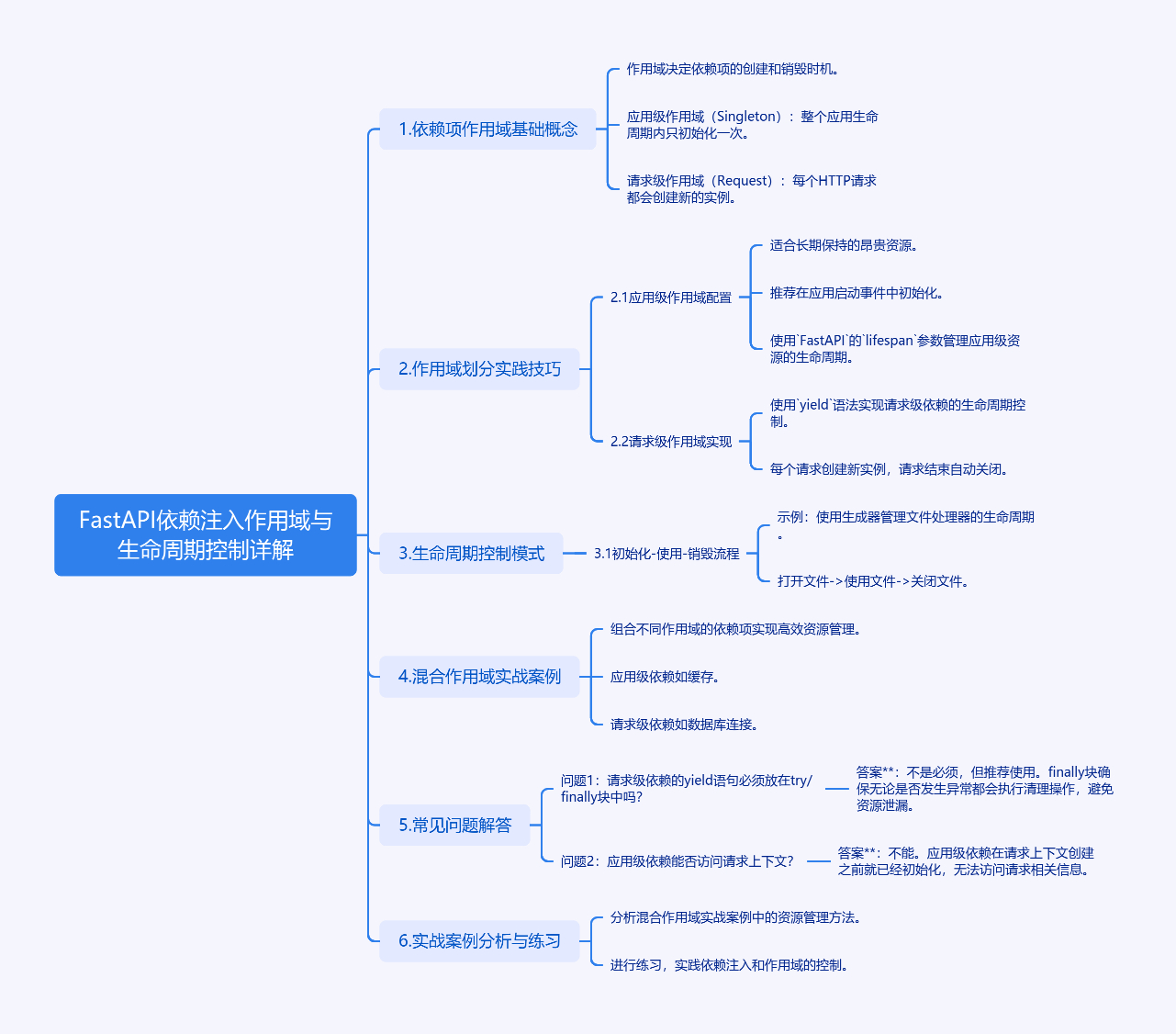FastAPI依赖注入作用域与生命周期控制


扫描二维码关注或者微信搜一搜:编程智域 前端至全栈交流与成长
FastAPI依赖注入作用域与生命周期控制详解
1. 依赖项作用域基础概念
在FastAPI框架中,依赖项的作用域决定了它们的创建和销毁时机。就像图书馆里的公共设施(应用级)与个人借阅的书籍(请求级)的区别,不同作用域的依赖项适用于不同的使用场景。
作用域主要分为两种类型:
- 应用级作用域(Singleton):整个应用生命周期内只初始化一次
- 请求级作用域(Request):每个HTTP请求都会创建新的实例
1 | from fastapi import Depends, FastAPI |
2. 作用域划分实践技巧
2.1 应用级作用域配置
适合需要长期保持的昂贵资源,推荐在应用启动事件中初始化:
1 | from contextlib import asynccontextmanager |
2.2 请求级作用域实现
使用yield语法实现请求级依赖的生命周期控制:
1 | from fastapi import Depends |
3. 生命周期控制模式
3.1 初始化-使用-销毁流程
1 | from typing import Generator |
4. 混合作用域实战案例
组合不同作用域的依赖项实现高效资源管理:
1 | from fastapi import Depends, BackgroundTasks |
5. 课后Quiz
问题1:请求级依赖的yield语句必须放在try/finally块中吗?
答案:不是必须,但推荐使用。finally块确保无论是否发生异常都会执行清理操作,避免资源泄漏
问题2:应用级依赖能否访问请求上下文?
答案:不能。应用级依赖在请求上下文创建之前就已经初始化,无法访问请求相关信息
6. 常见报错解决方案
错误1:RuntimeError: Dependency is not yield
原因:在异步依赖项中忘记使用yield语法
1 | # 错误示例 |
错误2:DependencyOveruseWarning
现象:频繁创建昂贵资源导致性能问题
解决:检查依赖项作用域是否合理,将数据库连接池等昂贵资源改为应用级作用域
错误3:ContextVariableNotFound
场景:在应用级依赖中尝试访问请求信息
处理:将需要请求信息的依赖改为请求级作用域,或通过参数传递所需数据
7. 环境配置与运行
安装依赖:
1 | pip install fastapi uvicorn sqlalchemy python-dotenv |
启动服务:
1 | uvicorn main:app --reload --port 8000 |
测试端点:
1 | curl http://localhost:8000/items |
通过合理划分依赖项的作用域和精确控制生命周期,开发者可以显著提升FastAPI应用的性能和资源利用率。建议在实践中结合具体业务需求,通过性能测试确定最佳作用域配置方案。
余下文章内容请点击跳转至 个人博客页面 或者 扫码关注或者微信搜一搜:编程智域 前端至全栈交流与成长,阅读完整的文章:
往期文章归档:
- FastAPI依赖注入实践:工厂模式与实例复用的优化策略 | cmdragon’s Blog
- FastAPI依赖注入:链式调用与多级参数传递 | cmdragon’s Blog
- FastAPI依赖注入:从基础概念到应用 | cmdragon’s Blog
- FastAPI中实现动态条件必填字段的实践 | cmdragon’s Blog
- FastAPI中Pydantic异步分布式唯一性校验 | cmdragon’s Blog
- 掌握FastAPI与Pydantic的跨字段验证技巧 | cmdragon’s Blog
- FastAPI中的Pydantic密码验证机制与实现 | cmdragon’s Blog
- 深入掌握FastAPI与OpenAPI规范的高级适配技巧 | cmdragon’s Blog
- Pydantic字段元数据指南:从基础到企业级文档增强 | cmdragon’s Blog
- Pydantic Schema生成指南:自定义JSON Schema | cmdragon’s Blog
- Pydantic递归模型深度校验36计:从无限嵌套到亿级数据的优化法则 | cmdragon’s Blog
- Pydantic异步校验器深:构建高并发验证系统 | cmdragon’s Blog
- Pydantic根校验器:构建跨字段验证系统 | cmdragon’s Blog
- Pydantic配置继承抽象基类模式 | cmdragon’s Blog
- Pydantic多态模型:用鉴别器构建类型安全的API接口 | cmdragon’s Blog
- FastAPI性能优化指南:参数解析与惰性加载 | cmdragon’s Blog
- FastAPI依赖注入:参数共享与逻辑复用 | cmdragon’s Blog
- FastAPI安全防护指南:构建坚不可摧的参数处理体系 | cmdragon’s Blog
- FastAPI复杂查询终极指南:告别if-else的现代化过滤架构 | cmdragon’s Blog
- FastAPI 核心机制:分页参数的实现与最佳实践 | cmdragon’s Blog
- FastAPI 错误处理与自定义错误消息完全指南:构建健壮的 API 应用 🛠️ | cmdragon’s Blog
- FastAPI 自定义参数验证器完全指南:从基础到高级实战 | cmdragon’s Blog
- FastAPI 参数别名与自动文档生成完全指南:从基础到高级实战 🚀 | cmdragon’s Blog
- FastAPI Cookie 和 Header 参数完全指南:从基础到高级实战 🚀 | cmdragon’s Blog
- FastAPI 表单参数与文件上传完全指南:从基础到高级实战 🚀 | cmdragon’s Blog
- FastAPI 请求体参数与 Pydantic 模型完全指南:从基础到嵌套模型实战 🚀 | cmdragon’s Blog
- FastAPI 查询参数完全指南:从基础到高级用法 🚀 | cmdragon’s Blog
- FastAPI 路径参数完全指南:从基础到高级校验实战 🚀 | cmdragon’s Blog
- FastAPI路由专家课:微服务架构下的路由艺术与工程实践 🌐 | cmdragon’s Blog
- FastAPI路由与请求处理进阶指南:解锁企业级API开发黑科技 🔥 | cmdragon’s Blog
- FastAPI路由与请求处理全解:手把手打造用户管理系统 🔌 | cmdragon’s Blog
- FastAPI极速入门:15分钟搭建你的首个智能API(附自动文档生成)🚀 | cmdragon’s Blog
- HTTP协议与RESTful API实战手册(终章):构建企业级API的九大秘籍 🔐 | cmdragon’s Blog
- HTTP协议与RESTful API实战手册(二):用披萨店故事说透API设计奥秘 🍕 | cmdragon’s Blog
